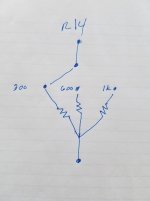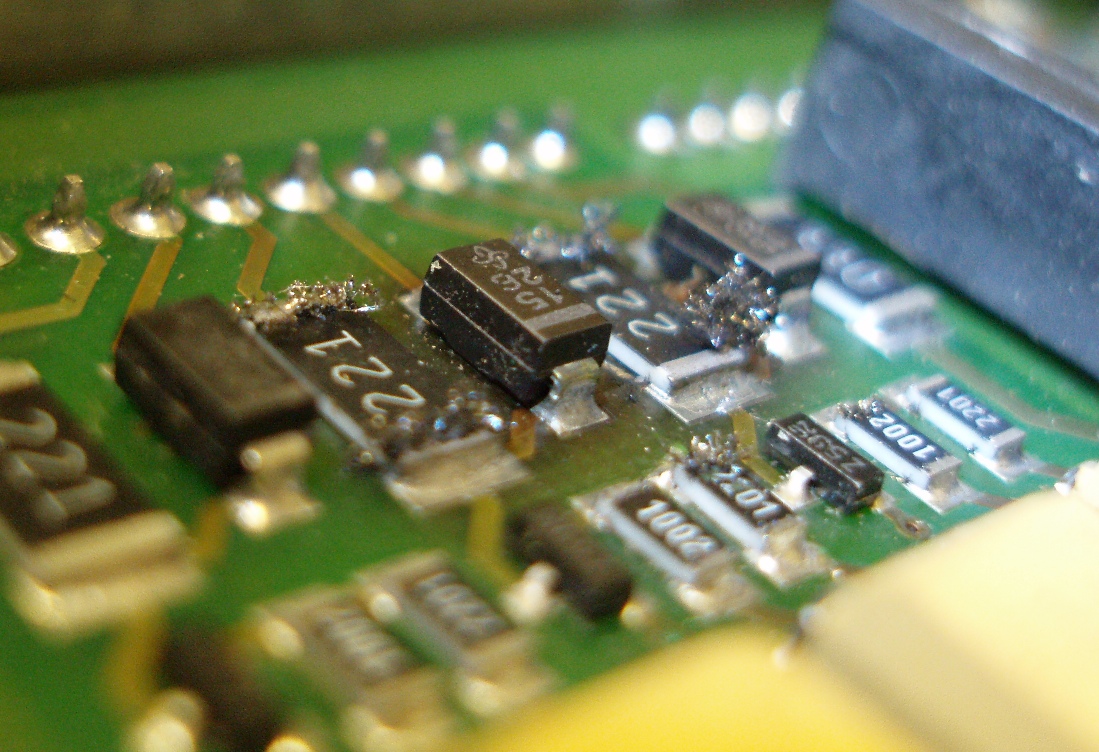I just added 3 position rotary switches to mine for gain adjustment. Works quite well. I run .25mv carts with no stepup.
So you have like 3 values of R14 to shift with the switch?
Cool🙂
So you have like 3 values of R14 to shift with the switch?
Cool🙂
Yes 300, 600, and 1k. Non-shorting rotary switches and there is zero noise when switching. 🙂
Yes 300, 600, and 1k. Non-shorting rotary switches and there is zero noise when switching. 🙂
Very nice🙂
Do you have wires from the location of the resistor to the switch - and back? Or have you managed to place the switch near both PCBs in some way?
I used shielded wire and noticed no additional noise.
I know it would be a pain to take pic of this implementation, do you perhaps already have a pick of this setup? Do you happen to remember what switching device you used?
Getting ready to use some lower output MC, this would be super handy...
Russellc
I know it would be a pain to take pic of this implementation, do you perhaps already have a pick of this setup? Do you happen to remember what switching device you used?
Getting ready to use some lower output MC, this would be super handy...
Russellc
Part is here: A10303RNZQ C&K Components | Mouser
Wiring is like the drawing attached.🙂
Attachments
Thanks, much appreciated!
Russelc
It looks like a fairly large part, do you have a knob on the outside of the chassis? It looks large enough for those purposes. Or is it concealed inside?
Russellc
It looks like a fairly large part, do you have a knob on the outside of the chassis? It looks large enough for those purposes. Or is it concealed inside?
Russellc
You need to be able to turn the rotary switch.
You need to be able to turn the rotary switch.
Hate to drill a hole through my face plate, I guess I could have it exit the rear panel. If it isnt too large, I can conceal it inside. I will not need to change carts very often, so no big deal for me to make "internal" adjustment. Maybe even a small board inside with Tiny DIP type switches...
Russellc
Do you have 2 of these single pole switches - or should it be A20303RNZQ for double pole ?
I used 2. Do you mean 2 pole or 2 deck? I'm not fully up on switch terminology.
I meant 2 pole - but when you used 2 that explains my confusion 🙂🙂
If you have room, add extra phono sockets to the back panel and wire in paralell to the input sockets, solder 'loading' resistor(s) inside a phono plug(s) and insert .....
If you have room, add extra phono sockets to the back panel and wire in paralell to the input sockets, solder 'loading' resistor(s) inside a phono plug(s) and insert .....
Thats also a very good methtod. 🙂
Its similar to what I have on the back of my Thorens TD126 Mk III Centenial, where the ekstra plugs original was ment to be used for capacitors for MM-pickups.
Resistors? Is 0.25W mandatory?
Hi
I am a litle confused as the description of the parts needed says all resistors are 0.25W - but Wayne also writes that he mostly uses Vishay-Dale RN55D - which I think are only 0.125W 😕
I think I could use Vishay-Dale RN60D? What are your oppinions in selecting restistors?
And by the way - why are the CMF-series more expensive than the RN series ? I would have imagined it would be the other way round (RN being military grade)?
The nice guy I bought the project from is talking warmly of Welwyn (but they are rather expensive)...
As always all your kind input is welcome 🙂
Hi
I am a litle confused as the description of the parts needed says all resistors are 0.25W - but Wayne also writes that he mostly uses Vishay-Dale RN55D - which I think are only 0.125W 😕
I think I could use Vishay-Dale RN60D? What are your oppinions in selecting restistors?
And by the way - why are the CMF-series more expensive than the RN series ? I would have imagined it would be the other way round (RN being military grade)?
The nice guy I bought the project from is talking warmly of Welwyn (but they are rather expensive)...
As always all your kind input is welcome 🙂
The RN series are derated for the military spec. The 1/4w resistors in the RN series are actually 1/2w devices. In your example the RN55 say 1/8w on the datasheet but are functionally identical to the CMF55 1/4w
The RN are also not lead-free (because the mil-spec understands the disaster that is lead-free solder and components) and being leaded, are difficult to sell.
The RN are also not lead-free (because the mil-spec understands the disaster that is lead-free solder and components) and being leaded, are difficult to sell.
The RN series are derated for the military spec. The 1/4w resistors in the RN series are actually 1/2w devices. In your example the RN55 say 1/8w on the datasheet but are functionally identical to the CMF55 1/4w
Thanks for making this clear
 🙂
🙂 The RN55's will be allright then.
The RN are also not lead-free (because the mil-spec understands the disaster that is lead-free solder and components) and being leaded, are difficult to sell.
😀
The RN are also not lead-free (because the mil-spec understands the disaster that is lead-free solder and components) and being leaded, are difficult to sell.
Failing diodes, MOSFETs etc in aerospace gear.
- Home
- Amplifiers
- Pass Labs
- Pearl Two

